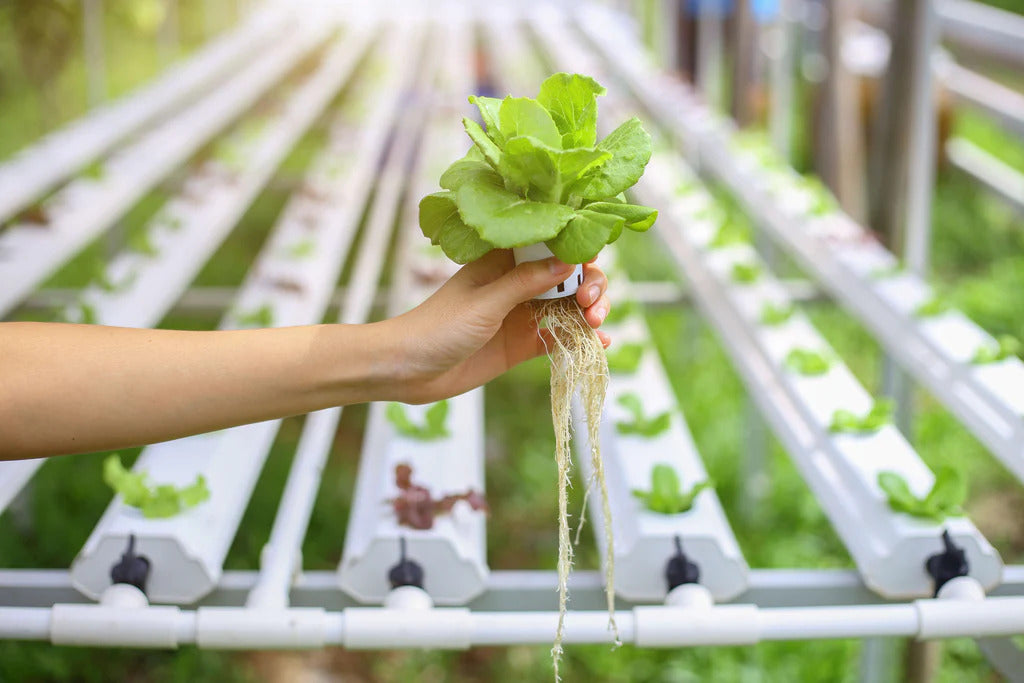How To Build A Hydroponic Garden
Starting your own hydroponic garden might sound like a task that's out of this world, but it's actually pretty straightforward and super fun! Imagine having your very own garden where plants don't even need soil to grow. Yep, you heard that right!
With a hydroponic garden, your plants grow in water, which means you can do it indoors, no matter the weather outside. Plus, it's kind of like having a science experiment in your own home.
In this guide, we'll walk you through everything you need to know to get your hydroponic garden up and thriving.
Step-by-Step Instructions for Building a Hydroponic Garden

Whether you are an experienced hydroponic grower or a gardening enthusiast looking to try something new, building a hydroponic garden can be a fun and rewarding project with a little know-how and a few basic supplies.
Create the Floating Platform
To keep your plants happy and healthy in a hydroponic garden, you're going to make a cool floating platform. First, grab some styrofoam. This stuff is lightweight and perfect for making a platform that can float on water.
You'll want to cut the styrofoam to fit the size of your water container. Make sure there's a little room around the edges so it can easily move up and down.
This moving part is really important because it lets the roots of your plants always get just the right amount of water without getting too soggy. No one likes soggy roots!
Fill the Reservoir with Fresh Water
Hydroponic plants rely on a nutrient-rich water solution to thrive, and using water that is free from contaminants can prevent damage and diseases from affecting your plants.
Regularly monitoring and adjusting the water quality in your hydroponic system is also essential. Adding tap water to your reservoir as needed can help maintain the proper balance of nutrients, and prevent any potential issues that may arise from stagnant water.
To fill the reservoir with fresh water, start by emptying any old or stagnant water and flushing the system thoroughly with fresh water. Once the system is clean and ready, simply fill the reservoir with the recommended gallon of water based on the size of your container.
Place the Containers/Pots in the Reservoir
This is essential for ensuring the healthy growth of your plants, as they rely on nutrient-rich water to thrive. Here’s how to do it:
- Choose the right size containers: Before placing your containers or pots in the reservoir, make sure they are the correct size to fit into the space without overcrowding. This is important, as too many containers can affect the water circulation and quality. Leave ample space to fit the water pump.
- Prepare the containers: When you’re ready to place the containers, fill each one with some peat moss to provide support for the roots of your plants. This will help give them a stable base to grow from and ensure they have the hydroponic nutrients they need.
- Carefully place the containers: Once you have your containers filled and ready to go, carefully place them into the reservoir. Make sure they are stable and secure so that they don't tip over or move around too much.
Drill Holes in the Bottom of Each Container/Pot
When setting up your hydroponic garden, one crucial step is to drill holes in the bottom of each container/pot. This allows for proper drainage and aeration of your plant's roots. Here's how to do it:
- The number of holes to drill on the bottom of each container/pot depends on the size of your plants. Generally, smaller plants would require about 1-2 holes, and larger plants may need up to 4 holes. Ensure that the holes are evenly spaced out to avoid overcrowding.
- You will need a power drill and drill bits suitable for the size of holes you need. You will also need an appropriate container/pot and growing medium. Before drilling the holes, ensure that the hydroponic growing medium is slightly packed into each container/pot.
- Using the drill bits, carefully drill holes at the bottom of the container/pot. Be careful not to drill too many holes too close to each other or too close to the edges. The holes need to be big enough to allow proper drainage and aeration for the roots but not too big that the growing medium falls out.
- After drilling the holes, check that there is proper drainage by filling the container/pot with adequate water. Ensure that the water drains out without any obstructions, indicating that the holes are of the appropriate size and spacing.
Add Peat Moss to Each Container/Pot
When setting up a hydroponic garden, one of the important steps is to add a growing medium to the containers or pots before planting any seeds or seedlings. Peat moss is a popular choice among hydroponic growers due to its ability to retain moisture and provide essential nutrients to plants.
To add peat moss to each container or pot, start by pouring a small amount of the growing medium into each container. Aim to fill about one-third of the space, leaving enough room for the roots and nutrient-rich water.
Next, gently press down on the peat moss to even it out. However, make sure not to compact it too tightly as it can prevent water and oxygen from reaching the roots. A light press down should be enough to ensure the peat moss stays in place.
Add the Plants and Begin Growing
Now comes the exciting part – adding your plants to the hydroponic garden! First, you need to choose whether you want to start from seeds or seedlings. Seeds might take a bit longer to grow, but they can be exciting to watch as they sprout and grow. Seedlings, on the other hand, give you a bit of a head start.
Here’s what to do next:
- If starting with seeds: Sprinkle a few seeds into each container on top of the peat moss. Cover them lightly with a bit more peat moss, just so they're not exposed. Then, gently mist them with water.
- If starting with seedlings: Make a small hole in the center of the peat moss in each container. Carefully place your seedling in the hole, ensuring the roots are touching the peat moss. Then, gently cover the base with a bit more peat moss to secure the seedling in place.
Once your plants or seeds are in place, it’s time to turn on your hydroponic system. Make sure the water pump is working and that water is flowing properly through the system. This water will carry nutrients to your plants, helping them grow strong and healthy.
Materials Needed for Building a Hydroponic Garden

Some of the basic materials include plastic containers, PVC pipes, grow lights, air pumps, nutrient solutions, and water reservoirs.
Water Level Meter
A water level meter is an essential tool for anyone engaging in hydroponic gardening. Hydroponic gardening involves growing plants without soil, using nutrient-rich water instead. To ensure that the plants receive the necessary nutrients, it is important to maintain a consistent water level in your hydroponic system. Failure to do so may result in inadequate watering or overwatering, which can lead to unhealthy and stunted plants.
Air Pump
An air pump helps to increase the amount of oxygen dissolved in the nutrient-rich water, which is essential for the growth of healthy plants.
One of the primary reasons why an air pump is important in a hydroponic garden is that it provides aeration for the plant roots. Without proper aeration, the roots may suffocate and rot, resulting in stunted growth or the death of the plant.
Submersible Pump
This pump sits within your water reservoir, drawing water and distributing it through your PVC piping system or spout. To ensure that your pump performs effectively, it's important to select the right type of submersible pump for your hydroponic garden.
When selecting a submersible pump, you must consider the capacity of your water reservoir, the water flow rate you desire, and the depth at which the pump must operate. Your water reservoir capacity will determine the power of the pump you need. If you have a larger water reservoir, you'll need a stronger pump to move the water.
Nutrient-Rich Water Solution
With hydroponic gardening, a nutrient-rich water solution is crucial for healthy and robust plant growth. Here is a step-by-step guide on how to prepare the perfect nutrient solution for your hydroponic garden.
- Test Water pH and Electrical Conductivity: Before preparing the nutrient solution, you should test the water source for its pH and electrical conductivity (EC). This information is essential as it will help you determine the appropriate nutrient levels.
- Adjust pH Levels: To ensure that your nutrient solution is balanced, adjust the pH levels according to the test results. Acidifiers like sulfuric, nitric, citric, or phosphoric acid can be used to lower the pH. On the other hand, hydroponic-approved base solutions or household baking soda can be used to increase it.
- Avoid Using Rainwater: Although rainwater is a natural water source, it is not recommended for hydroponic gardening due to its high risk of harboring harmful bacteria and parasites.
- Add Hydroponic Liquid Fertilizers: Next, add hydroponic liquid fertilizers to complete the nutrient solution. These fertilizers are readily available in hydroponic stores and online. Ensure you follow the manufacturer's instructions and account for the size of your water reservoir.
- Mix the Nutrient Solution: Mix the nutrient solution thoroughly to ensure an even distribution of nutrients. The solution should be well-aerated and oxygenated, vital for healthy plant growth.
Plastic Containers or Pots
There are various types of plastic containers or pots that are suitable for hydroponic gardening. Let's take a closer look at what to consider when choosing the containers for your hydroponic garden.
Firstly, the container should be made of opaque plastic to ensure that the roots of your plants are protected from light. Exposure to light can lead to the growth of algae or other harmful microorganisms that can affect the health of your plants. Therefore, choosing opaque containers is very important.
Secondly, the containers should be deep enough to accommodate the root systems of your plants. The roots need enough space to grow and develop properly. Using shallow containers can limit the growth potential of your plants and may even lead to stunted growth.
Grow Light (optional)
If you're starting a hydroponic garden, investing in a grow light can be one of the best decisions you make. When using hydroponic systems, plants need a consistent source of light in order to grow properly, and a grow light can provide that.
- Types of Bulbs: When it comes to hydroponic gardening, there are two main types of light bulbs you'll want to consider - LED and fluorescent lights. Fluorescent bulbs are a more affordable option and work well for smaller plants like herbs and greens. LED lights, on the other hand, are a bit more expensive but last longer and are more energy-efficient.
- Configuration: There are a variety of configurations to choose from when it comes to grow lights. Freestanding lights are the most popular and can be placed anywhere in the room. Wall-mounted lights are ideal for those with limited space. Hanging lights hang over the plants and can be adjusted as the plants grow.
- Light Schedule: It's important to maintain a consistent light schedule when using a grow light in your hydroponic garden. Most plants need between 15 to 20 hours of light each day to grow properly. The best way to ensure you're providing adequate light is to set a timer to turn your grow light on and off at the same time each day.
Pipes (optional)
Using a piping system for hydroponic gardening is a great way to provide an organized and efficient way to grow healthy plants. If you decide to use pipes for your hydroponic system, be sure to use elbows, tees, and a water pump to help circulate the nutrient-enriched water.
What Are the Benefits of a Hydroponic Garden?
Hydroponic gardening has some awesome benefits that make it really cool for growing plants. Here's what's great about it:
|
Needs No Soil |
You don't need dirt to grow plants; this is super neat because it means you can grow them pretty much anywhere, even inside your house or apartment. |
|
Conserves Water |
It's way better for saving water. Plants get water directly to their roots, and this system reuses water over and over. |
|
Facilitates a Micro-Climate |
You can create the perfect little weather system for your plants. This means they can grow happy and healthy, no matter what the weather's like outside. |
|
Predictability and Seasonality |
You get to grow plants all year round. No need to wait for the right season. |
|
Crops Grow Faster |
Because they get exactly what they need, plants grow quicker than they do in soil. |
|
Maximizes Space |
You can grow a lot more in a smaller space. This is awesome if you don’t have a big backyard. |
|
Produces Higher Yields |
You get more fruits, veggies, or whatever you're growing. This means more food or flowers from each plant. |
|
Requires Less Labor |
No need for traditional gardening chores like weeding, which means it's easier on your back and your schedule. |
Hydroponic gardening rocks for these reasons, making it a great choice for anyone who loves plants.
Tips For Maintaining Your Hydroponic Garden

Hydroponic gardening is a cool way to grow plants without using dirt. Instead, you use water mixed with special plant food. Even though it's different from regular gardening, it's not too hard to get the hang of it, especially with these tips.
- Change the Water Often: Keep your plant's water fresh by changing it every two weeks or so. Depending on the plant, you might need to do this more or less often.
- Check the Water's pH and Nutrients: Use tools like a pH pen or a nutrient meter to make sure your water has the right amount of good stuff for your plants. This helps your plants grow big and strong.
- Learn About Your Plants: Find out what specific things your plants need by reading up on them. This way, you can make sure they get the right nutrients and care.
- Start Small: If you're new to this, try starting with a simple system that doesn't cost much. It's a great way to learn the basics, like how to manage nutrients and take care of your plants.
- Keep an Eye on Things: By staying on top of changing the water, checking on the nutrients, and learning more about your plants, you can keep your hydroponic garden thriving.
With these tips, you can grow lots of healthy plants in your hydroponic garden, even if you're just starting out.
Ready To Start Your Own Hydroponic Adventure?
Hydroponic gardening is a fantastic way to grow your favorite plants all year round, without the mess of soil and with less water. Whether you're a pro gardener or just starting out, hydroponics can bring loads of benefits, like faster growth and more harvests from each plant.
If you're keen to get started or level up your hydroponic game, we've got everything you need at Canada Grow Supplies, from detailed guides on our blog to all the supplies you'll need.
Reach out and contact us; we're here to help you grow! Remember, no matter what you're looking to grow, you can find all the supplies, tips, and tricks for a thriving garden right here with us.








